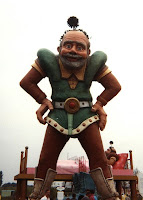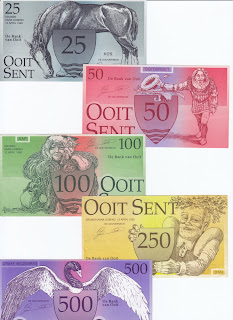But the 'notes' were in a way legal tender in this particular part of the Netherlands. (Drunen)
Let me explain.
In the '90 of last century, there was a childrens' theme park, called 'Land van Ooit' (Everland).
The park can be seen as a 'do it yourself - attraction park'. The main idea was a park without much "modern" attractions as rollercoasters or highspeed watersplashes.
All staff were actually actors who played within a setting of medieval castles, knights, trolls, whiches and princes.
In Everland, children were the knights, their parents were their servants.
Many acttractions were to be played with human power (unmotorised cars).
At the entrance of the park, an exchange office was build, and dutch guilders could be exchanged for 'ooit-cents' (ever-cents), at a rate of 1 = 1.
1 dutch guilder (=100 cents) was exchanged for 100 'ever-cents'.
All prices in the park were therefore in ever-cents currency.
There were no coins in use, only 6 banknotes.
The banknotes are not etirely fake, since they represent a certain value, and they were exchangable (at the park) for dutch guilders again.
All notes are numbered too.
The highest value, was a 1000 Ooit sent (similar to 1000 Dutch cents), or 10 Dutch Guilders.
 |
| 1000 Ooit sent |
 |
| 1000 Ooit sent - reverse |
The idea was great, but due to the fact that almost all attractions were outside, and the weather in this part of Europe isn't really the best place to have only outdoor activities, made that the theme park got bankrupt in 2007.
A smaller park in the belgian city Tongeren (in a Roman empire setting) failed that same year.





2 comments:
Thank you! I found a bag of these in a book i bought at a used book store in colorado and i could not figure out what they were.
Hi, thanks for your commment.
It's great to hear my blog was useful.
Post a Comment